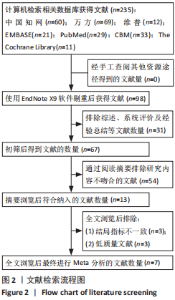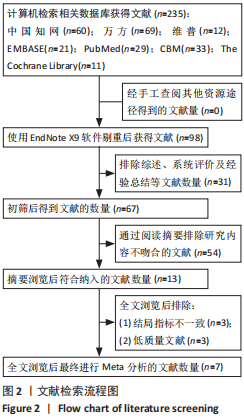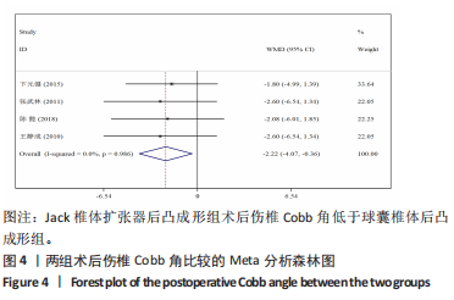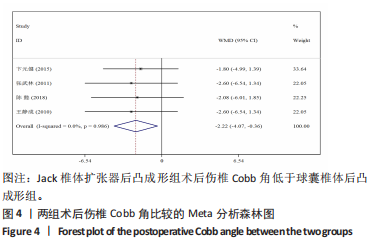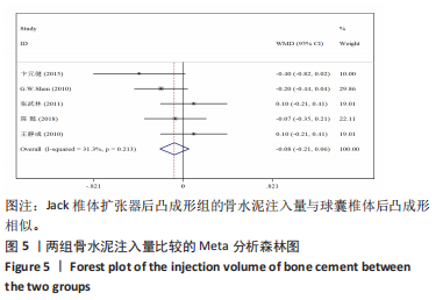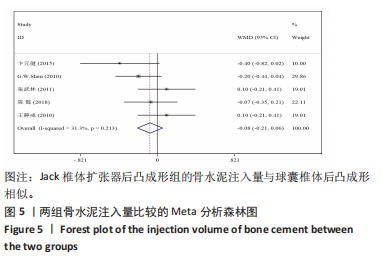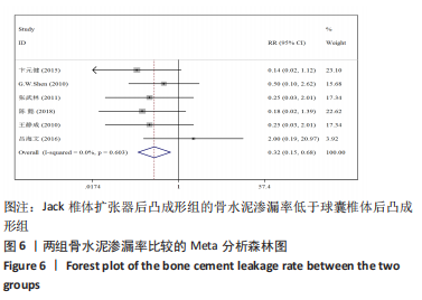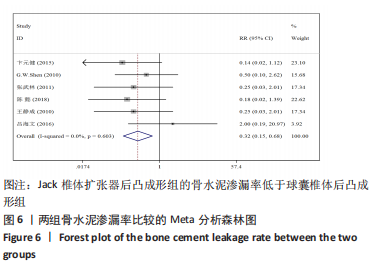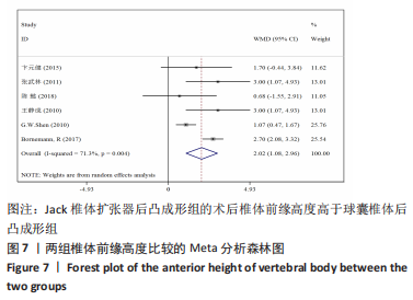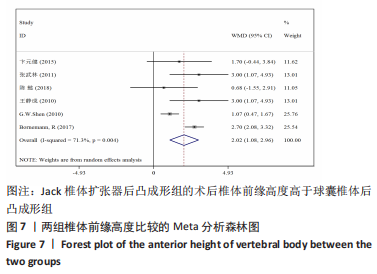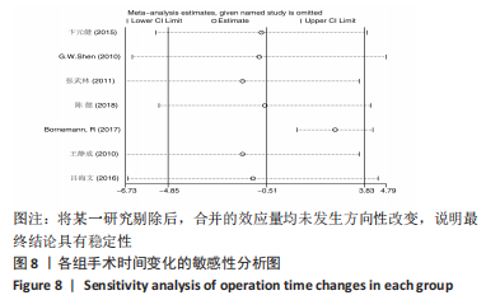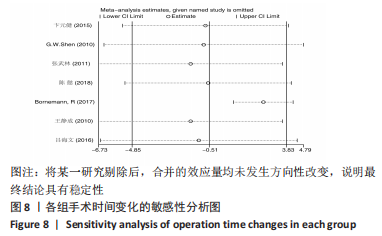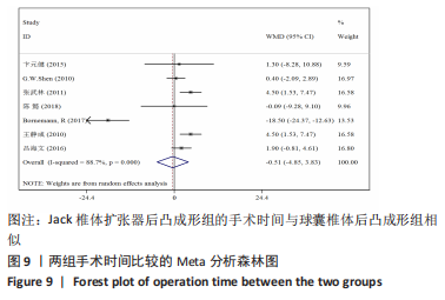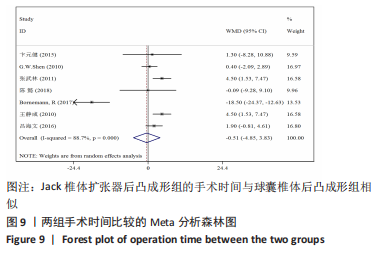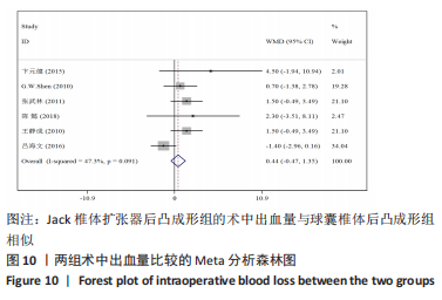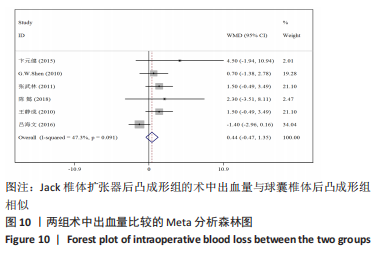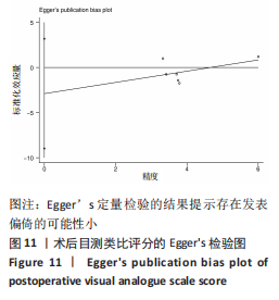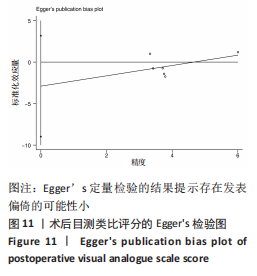Chinese Journal of Tissue Engineering Research ›› 2022, Vol. 26 ›› Issue (3): 487-492.doi: 10.12307/2022.080
Meta-analysis of efficacy and safety of Jack kyphoplasty for osteoporotic vertebral compression fractures
Zhong Yuanming1, He Bingkun2, Wu Zhuotan2, Wu Sixian2, Wan Tong2, Zhong Xifeng2
- 1The First Affiliated Hospital of Guangxi University of Chinese Medicine, Nanning 530001, Guangxi Zhuang Autonomous Region, China; 2Graduate School of Guangxi University of Chinese Medicine, Nanning 530001, Guangxi Zhuang Autonomous Region, China
-
Received:2020-07-22Revised:2020-07-24Accepted:2020-11-26Online:2022-01-28Published:2021-10-29 -
Contact:Zhong Yuanming, The First Affiliated Hospital of Guangxi University of Chinese Medicine, Nanning 530001, Guangxi Zhuang Autonomous Region, China -
About author:Zhong Yuanming, Doctoral supervisor, Professor, Chief physician, The First Affiliated Hospital of Guangxi University of Chinese Medicine, Nanning 530001, Guangxi Zhuang Autonomous Region, China -
Supported by:the National Natural Science Foundation of China, No. 81760874 (to ZYM); the First Class Discipline Project of Traditional Chinese Medicine in Guangxi Zhuang Autonomous Region, No. GJKY[2018]12 (to ZYM)
CLC Number:
Cite this article
Zhong Yuanming, He Bingkun, Wu Zhuotan, Wu Sixian, Wan Tong, Zhong Xifeng. Meta-analysis of efficacy and safety of Jack kyphoplasty for osteoporotic vertebral compression fractures[J]. Chinese Journal of Tissue Engineering Research, 2022, 26(3): 487-492.
share this article
Add to citation manager EndNote|Reference Manager|ProCite|BibTeX|RefWorks
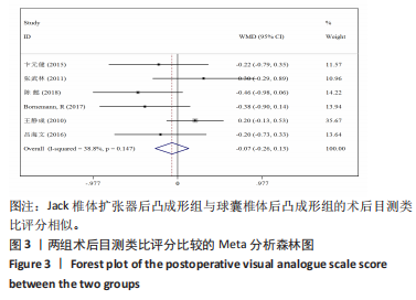
2.2 文献质量评价结果 纳入的7篇文献中[10,15-20],有3篇为随机对照试验[10,16,19],另外4篇为回顾性分析[15,17-18,20]。文章的3个随机对照试验均按随机原则进行病例分组,但未具体描述随机方法、分配、评价和脱落情况,文献等级评为B级;4个回顾性分析经NOS量表评价后,其中3个队列研究为7 分[15,18,20],另外1个研究为6分[17],见表1。 2.3 Meta分析结果 2.3.1 各组术后目测类比评分变化 纳入的6个研究比较了两组患者的术后目测类比评分[15-20]。固定效应模型Meta分析结果显示,DKP组与球囊椎体后凸成形组的目测类比评分相比,差异无显著性意义(MD=-0.07,95%CI: -0.26-0.13,P > 0.05),见图3。"
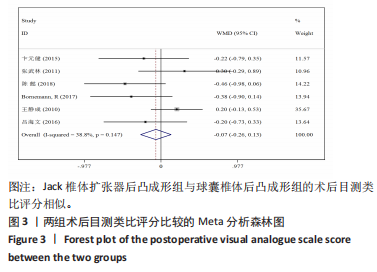
| [1] 阙敏强,石础硕,黄英杰,等.不同药物治疗原发性骨质疏松症的网状Meta分析[J].中国组织工程研究,2020,24(35):5715-5722. [2] LOCANTORE P, DEL GATTO V, GELLI S, et al. The Interplay between Immune System and Microbiota in Osteoporosis. Mediators Inflamm. 2020;2020:3686749. [3] PISANI P, RENNA MD, CONVERSANO F, et al. Major osteoporotic fragility fractures: risk factor updates and societal impact. World J Orthop. 2016;7(3):171. [4] HUANG S, ZHU X, XIAO D, et al. Therapeutic effect of percutaneous kyphoplasty combined with anti-osteoporosis drug on postmenopausal women with osteoporotic vertebral compression fracture and analysis of postoperative bone cement leakage risk factors: a retrospective cohort study. J Orthop Surgery Res. 2019;14(1):1-12. [5] FUSCO A. Benefits and harms of percutaneous vertebroplasty for the treatment of osteoporotic vertebral compression fracture: a cochrane review summary with commentary. Am J Phys Med Rehabil. 2019;98(12):1151-1152. [6] YANG W, SONG J, LIANG M, et al. Functional outcomes and new vertebral fractures in percutaneous vertebroplasty and conservative treatment of acute symptomatic osteoporotic vertebral compression fractures. World Neurosurg. 2019;131:e346-e352. [7] ZHANG JN, HE X, FAN Y, et al. Risk factors for conservative treatment failure in acute osteoporotic vertebral compression fractures (OVCFs). Arch Osteop. 2019;14(1):24. [8] 侯伟,熊小明,万趸,等.球囊与扩张矫形器辅助的椎体后凸成形术治疗骨质疏松性椎体压缩骨折的比较[J].中国矫形外科杂志, 2017, 25(18):1633-1636. [9] ZHU Y, CHENG J, YIN J, et al. Therapeutic effect of kyphoplasty and balloon vertebroplasty on osteoporotic vertebral compression fracture: a systematic review and meta-analysis of randomized controlled trials. Medicine. 2019; 98(45):e17810. [10] SHEN GW, WU NQ, ZHANG N, et al. A prospective comparative study of kyphoplasty using the Jack vertebral dilator and balloon kyphoplasty for the treatment of osteoporotic vertebral compression fractures. J Bone Joint Surg Br. 2010;92(9):1282-1288. [11] FAN J, SHEN Y, ZHANG N, et al. Evaluation of surgical outcome of Jack vertebral dilator kyphoplasty for osteoporotic vertebral compression fracture-clinical experience of 218 cases. J Orthop Surg Res. 2016;11(1):56. [12] SIETSMA MS, HOSMAN AJF, VERDONSCHOT NJJ, et al. Biomechanical evaluation of the vertebral jack tool and the inflatable bone tamp for reduction of osteoporotic spine fractures. Spine. 2009;34(18):E640-E644. [13] 印平,马远征,马迅,等.骨质疏松性椎体压缩性骨折的治疗指南[J].中国骨质疏松杂志,2015,21(6):643-648. [14] ZUO XH, ZHU XP, BAO HG, et al. Network meta-analysis of percutaneous vertebroplasty, percutaneous kyphoplasty, nerve block, and conservative treatment for nonsurgery options of acute/subacute and chronic osteoporotic vertebral compression fractures (OVCFs) in short-term and long-term effects. Medicine. 2018;97(29):e11544. [15] 卞元健,李大鹏,孙继芾,等.DKP与BKP治疗骨质疏松性椎体压缩骨折的临床对比研究[J].南京医科大学学报(自然科学版), 2015,35(8): 1136-1141. [16] 吕海文.微创Sky手术与球囊成形术治疗脊柱骨质疏松压缩性骨折的效果比较[J].国际医药卫生导报,2016,22(5):635-637. [17] 陈懿,陈晟,李作灵,等.Jack 椎体扩张器后凸成形术与球囊扩张后凸成形术对骨质疏松性椎体压缩骨折的疗效比较[J].蚌埠医学院学报,2018,43(2):210-212. [18] 王静成,冯新民,杨建东,等.Jack 椎体扩张器和球囊扩张后凸成形术的比较研究[J].中华骨科杂志,2010,30(9):842-847. [19] BORNEMANN R, ROESSLER PP, ROMMELSPACHER Y, et al. The vertect jack device: a new method for augmentation of vertebral fractures. clinical study with comparisons to kyphoplasty. Tech Health Care. 2017;25(4):739-747. [20] 张武林.椎体扩张器后凸成形术治疗骨质疏松性椎体压缩骨折的临床研究[D].扬州:扬州大学,2011. [21] MARTIKOS K, GREGGI T, FALDINI C, et al. Osteoporotic thoracolumbar compression fractures: long-term retrospective comparison between vertebroplasty and conservative treatment. Eur Spine J. 2018;27(2):244-247. [22] 姚仕奋,谢惠缄,陈民.经皮椎体后凸成形术不同手术时机治疗骨质疏松性椎体压缩性骨折的疗效观察[J].中国矫形外科杂志, 2015,23(18):1662-1666. [23] OH Y, LEE B, LEE S, et al. Percutaneous vertebroplasty versus conservative treatment using a transdermal fentanyl patch for osteoporotic vertebral compression fractures. J Korean Neurosurg Soc. 2019;62(5):594. [24] ALHASHASH M, SHOUSHA M, BARAKAT AS, et al. Effects of polymethylmethacrylate cement viscosity and bone porosity on cement leakage and new vertebral fractures after percutaneous vertebroplasty: a prospective study. Global Spine J. 2019;9(7):754-760. [25] 董明,杨华清,李强,等.经皮椎体后凸成形术治疗胸腰段椎体骨折伴腰骶臀区疼痛[J].中国矫形外科杂志,2020,28(8):755-757. [26] PUMBERGER M, SCHITZ F, BüRGER J, et al. Kyphoplasty restores the global sagittal balance of the spine independently from pain reduction. Sci Rep. 2020;10(1):1-6. [27] 王宇翔,徐海栋,赵建宁.球囊后凸成形术治疗骨质疏松椎体压缩性骨折[J].中国矫形外科杂志,2019,27(22):2088-2090. [28] GUO D, YU M, ZHANG S, et al. Novel surgical strategy for treating osteoporotic vertebral fractures with cord compression. Orthop Surg. 2019;11(6):1082-1092. [29] LI D, HUANG Y, YANG H, et al. Jack vertebral dilator kyphoplasty for treatment of osteoporotic vertebral compression fractures. Eur J Orthop Surg Traumatol. 2014;24(1): 15-21. [30] VANNI D, PANTALONE A, BIGOSSI F, et al. New perspective for third generation percutaneous vertebral augmentation procedures: Preliminary results at 12 months. J Craniovertebr Junction Spine. 2012;3(2):47-51. [31] 高健安,陈曦,张隆盛,等.经皮椎体后凸成形过程中脊柱植入物的种类及优势[J].中国组织工程研究,2020,24(12):26. [32] MA XL, XING D, MA JX, et al. Balloon kyphoplasty versus percutaneous vertebroplasty in treating osteoporotic vertebral compression fracture: grading the evidence through a systematic review and meta-analysis. Eur Spine J. 2012;21(9): 1844-1859. [33] ZHANG Y, SHI L, TANG P, et al. Comparison of the efficacy between two micro-operative therapies of old patients with osteoporotic vertebral compression fracture: a network meta-analysis. J Cell Biochem. 2017;118(10): 3205-3212. [34] VANNI D, PANTALONE A, BIGOSSI F, et al. New perspective for third generation percutaneous vertebral augmentation procedures: preliminary results at 12 months. J Craniovertebr Junction Spine. 2012;3(2):47. [35] SHEN GW, WU NQ, ZHANG N, et al. A prospective comparative study of kyphoplasty using the Jack vertebral dilator and balloon kyphoplasty for the treatment of osteoporotic vertebral compression fractures. J Bone Joint Surg Br. 2010;92(9):1282-1288. [36] 张宁,殷国勇,沈国蔚,等.椎体内复位扩张器在经皮后凸成形术治疗中的研究现状[J].实用老年医学,2010,24(5):367-371. |
| [1] | Xu Xinzhong, Wu Zhonghan, Yu Shuisheng, Zhao Yao, Xu Chungui, Zhang Xin, Zheng Meige, Jing Juehua. Biomechanical analysis of different ways of inserting Steinmann Pins into the femoral head [J]. Chinese Journal of Tissue Engineering Research, 2022, 26(9): 1313-1317. |
| [2] | Li Rui, Shi Wen, Yang Shicai, Lü Linwei, Zhang Chunqiu. Effect of splintage and Shenxiaosan cataplasm on fracture healing in rabbits with radial fracture model [J]. Chinese Journal of Tissue Engineering Research, 2022, 26(9): 1329-1333. |
| [3] | Yuan Jiabin, Zhu Zongdong, Tang Xiaoming, Wei Dan, Tan Bo, Xiao Chengwei, Zhao Ganlinwei, Liao Feng. Classification and reduction strategies for irreducible intertrochanteric femoral fracture based on anatomy [J]. Chinese Journal of Tissue Engineering Research, 2022, 26(9): 1341-1345. |
| [4] | Liu Feng, Feng Yi. Finite element analysis of different Kirschner wire tension bands on transverse patella fractures during gait cycle [J]. Chinese Journal of Tissue Engineering Research, 2022, 26(9): 1367-1371. |
| [5] | Yao Xiaoling, Peng Jiancheng, Xu Yuerong, Yang Zhidong, Zhang Shuncong. Variable-angle zero-notch anterior interbody fusion system in the treatment of cervical spondylotic myelopathy: 30-month follow-up [J]. Chinese Journal of Tissue Engineering Research, 2022, 26(9): 1377-1382. |
| [6] | Jiang Huanchang, Zhang Zhaofei, Liang De, Jiang Xiaobing, Yang Xiaodong, Liu Zhixiang. Comparison of advantages between unilateral multidirectional curved and straight vertebroplasty in the treatment of thoracolumbar osteoporotic vertebral compression fracture [J]. Chinese Journal of Tissue Engineering Research, 2022, 26(9): 1407-1411. |
| [7] | Yu Chengxiang, Liu Lehong, Li Wenbo, Chen Jinshi, Ran Chunlei, Wang Zhongping. Correlation between spine-pelvic sagittal parameters and prognosis of vertebroplasty in the treatment of thoracolumbar osteoporotic vertebral compression fractures [J]. Chinese Journal of Tissue Engineering Research, 2022, 26(9): 1412-1417. |
| [8] | Xue Yadong, Zhou Xinshe, Pei Lijia, Meng Fanyu, Li Jian, Wang Jinzi . Reconstruction of Paprosky III type acetabular defect by autogenous iliac bone block combined with titanium plate: providing a strong initial fixation for the prosthesis [J]. Chinese Journal of Tissue Engineering Research, 2022, 26(9): 1424-1428. |
| [9] | Zhuang Zhikun, Wu Rongkai, Lin Hanghui, Gong Zhibing, Zhang Qianjin, Wei Qiushi, Zhang Qingwen, Wu Zhaoke. Application of stable and enhanced lined hip joint system in total hip arthroplasty in elderly patients with femoral neck fractures complicated with hemiplegia [J]. Chinese Journal of Tissue Engineering Research, 2022, 26(9): 1429-1433. |
| [10] | Li Canhui, Wu Zhengjie, Zeng Yanhui, He Yinghao, Situ Xiaopeng, Du Xuelian, Hong Shi, He Jiaxiong. Advantage and disadvantage of robot-assisted sacroiliac screw placement and traditional fluoroscopy in orthopedic surgery [J]. Chinese Journal of Tissue Engineering Research, 2022, 26(9): 1434-1438. |
| [11] | Zhu Chan, Han Xuke, Yao Chengjiao, Zhou Qian, Zhang Qiang, Chen Qiu. Human salivary components and osteoporosis/osteopenia [J]. Chinese Journal of Tissue Engineering Research, 2022, 26(9): 1439-1444. |
| [12] | Li Wei, Zhu Hanmin, Wang Xin, Gao Xue, Cui Jing, Liu Yuxin, Huang Shuming. Effect of Zuogui Wan on bone morphogenetic protein 2 signaling pathway in ovariectomized osteoporosis mice [J]. Chinese Journal of Tissue Engineering Research, 2022, 26(8): 1173-1179. |
| [13] | Wang Jing, Xiong Shan, Cao Jin, Feng Linwei, Wang Xin. Role and mechanism of interleukin-3 in bone metabolism [J]. Chinese Journal of Tissue Engineering Research, 2022, 26(8): 1260-1265. |
| [14] | Xiao Hao, Liu Jing, Zhou Jun. Research progress of pulsed electromagnetic field in the treatment of postmenopausal osteoporosis [J]. Chinese Journal of Tissue Engineering Research, 2022, 26(8): 1266-1271. |
| [15] | Wu Bingshuang, Wang Zhi, Tang Yi, Tang Xiaoyu, Li Qi. Anterior cruciate ligament reconstruction: from enthesis to tendon-to-bone healing [J]. Chinese Journal of Tissue Engineering Research, 2022, 26(8): 1293-1298. |
| Viewed | ||||||
|
Full text |
|
|||||
|
Abstract |
|
|||||
